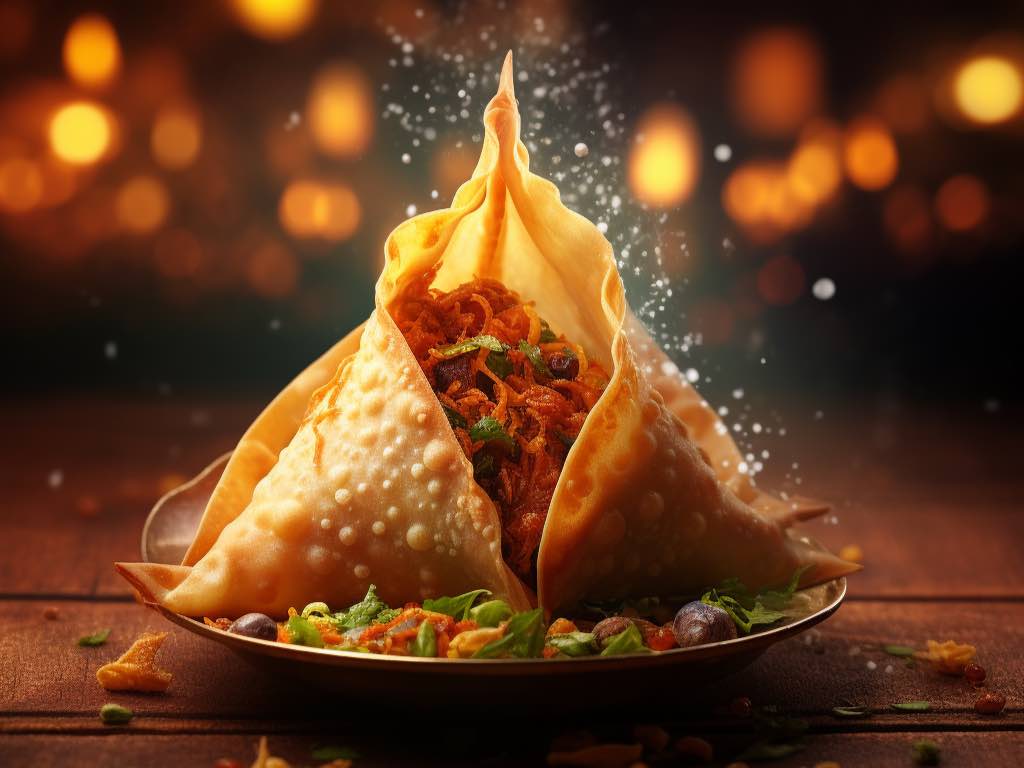
The Art of Samosa Wrappers: From Tradition to Innovation
|
|
Time to read 5 min
Welcome to One Stop Halal!
Written by: Najma A.
|
|
Time to read 5 min
Samosas, those delectable pockets of savory goodness, have been a beloved snack and street food across South Asia and the Middle East for centuries. While the filling of a samosa is often the star of the show, the wrapper, or the outer pastry shell, plays an equally crucial role in creating the perfect samosa experience. This blog will delve deep into the world of samosa wrappers, exploring their history, regional variations, and even some creative innovations that have brought this humble pastry to new heights.
The samosa, believed to have originated in the Middle East during the 9th century, has a fascinating history that spans several continents and cultures. Initially known as "sambusak," these pastry pockets were introduced to the Indian subcontinent by traders and travelers. Over time, the samosa underwent various adaptations, including changes to its wrapper, to suit the local tastes and ingredients.
One of the remarkable aspects of samosas is their ability to adapt and transform as they journey through different regions and cultures. Each locale has put its unique spin on this beloved snack's filling and wrapper, samosa sheets, samosa dough sheets resulting in a tempting array of regional variations.
India, the birthplace of the samosa, boasts a wide range of regional variations. In North India, where the samosa is a street food staple, you'll typically find samosas with a thicker, sturdier shortcrust pastry. These samosa wraps are often flavored with spices like ajwain (carom seeds) or cumin, adding an extra layer of flavor to the samosa. In contrast, South India offers a lighter and crisper pastry, making for a delightful textural contrast with the hearty filling. In West Bengal, samosas take on a unique twist with wrappers made from all-purpose flour and a hint of sugar, creating a harmonious balance of sweet and savory.
As the samosa journeyed westward, it changed to fit Middle Eastern tastes. Here, filo dough—a thin, flaky pastry—takes center stage. This delicate wrapper results in a light and crispy texture that complements the various fillings, ranging from minced meat to cheese or spinach. The Middle Eastern samosa is a testament to the adaptability of this snack across borders.
In countries like Somalia and Kenya, samosas, often known as "sambusa" or "sambuus," are popular street food. The wrappers here are typically made with a thin, wheat-based dough similar to their Indian counterparts. However, local spices and ingredients infuse these samosas with distinct flavors. Fillings often include minced meat, potatoes, and aromatic spices, showcasing the fusion of Indian influence and local African elements.
Indonesia and Malaysia have their version of samosas, locally known as "sambal goreng" or "karipap." These samosas are wrapped in a thin, translucent spring roll wrapper, creating a unique textural experience. The fillings are known for their spiciness and often feature minced meat, potatoes, and a fragrant blend of spices. Southeast Asian samosas illustrate the versatility of the snack as it melds with the vibrant flavors of the region. In essence, samosas are a culinary chameleon, adapting their wrappers and fillings to suit the tastes and ingredients of each region they encounter.
These regional variations showcase the diversity of flavors and textures and reflect the rich history of culinary exchanges and cross-cultural influences that have shaped the samosa into the beloved snack we know today. Whether you prefer the sturdy shortcrust of North India, the delicate filo pastry of the Middle East, or the translucent spring roll wrapper of Southeast Asia, samosas offer a delightful taste of the world's diverse culinary traditions.
In recent years, the samosa wrappers has undergone some exciting innovations that have taken this classic snack to new heights:
With a growing emphasis on health and dietary preferences, some samosa makers have started experimenting with whole wheat, gluten-free, or vegetable-based wrappers to cater to a broader audience.
As global cuisine continues to evolve, fusion samosas have become a trend. These samosas feature unconventional fillings like tofu, or dessert-inspired options like Nutella and bananas. The wrappers, too, might be made with non-traditional ingredients like wonton wrappers or puff pastry.
Bite-sized samosas have become a hit at parties and gatherings. They are often wrapped in smaller, more delicate pastry shells, making them perfect for snacking or serving as appetizers.
Many people have turned to baking as an alternative cooking method to reduce the amount of oil in traditional deep-fried samosas. Baked samosas are wrapped in the same conventional or innovative wrappers but are brushed with a small amount of oil and baked until golden brown.
Welcome to the Home of the Halal Samosas. We carry various marinated meat and samosas that are hard to find elsewhere. We deliver to your doorstep anywhere in the United States within 1-2 business days.
The samosa wrappers, often overshadowed by its flavorful filling, is vital in creating the perfect samosa. Its history is a testament to various cultures' culinary diversity and creativity worldwide. Whether you prefer the flaky filo pastry of the Middle East, the robust shortcrust of India, or the translucent spring roll wrappers of Southeast Asia, samosas continue to unite people through their diverse flavors andures.
As innovation continues to shape the culinary world, we can only anticipate more creative adaptations of the samosa wrappers, pushing the boundaries of tradition while preserving the essence of this beloved snack. So, the next time you savor a samosa, take a moment to appreciate the artistry and ingenuity behind its wrapper—the unsung hero that makes every bite a memorable experience.

© 2025 One Stop Halal, Inc.